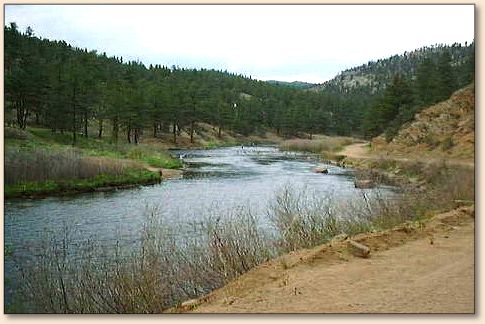Tributary Six
The 16 Inch Summer
By Carl Pudlo, Colorado
"The heart of the discerning acquires knowledge;
the ears of the wise seek it out." Proverbs 18:15
After listening to the man of the South Platte River
for more than an hour, I had to take my leave. I
remember the many experiences he had related to me,
experiences I had not yet encountered because I was
so new to the South Platte River and fly fishing its
many contours. After he related to me the next story,
I realized fly-fishing was not just a sport; it is an
experience of growth. As a child learns to crawl, then
walk, and then run, so a fisherman must evolve to higher
levels of the experience of fishing, first catching fish,
then competition, then big fish, then enjoyment, etc.
The Patriarch of the South Platte taught me it is the
normal growth of a fisherman to experience the different
levels of fishing, as in a graduation from elementary
school, to high school, and then onto college. He taught
me not to be concerned about the level of expertise of fishing...

"As fishing goes, one graduates to different levels of
fishing as experiences in piscatorial pursuits begin to
abound. When I first started fishing, my only concern
was to catch fish. As I grew older and hopefully wiser,
I wanted to catch bigger fish, then specific kinds of
fish, and now, I enjoy a very limited type of fishing,
trout fishing on streams with a fly rod and hand tied
flies. This growth to a specific type of fishing
enjoyment is an educational process, an evolution to a
point where just catching fish is no longer a concern
of an experienced fisherman. As a fisherman traverses
this evolutionary journey, he begins to enjoy other
aspects of fishing that never occurred to him as an
inexperienced youth. Experience teaches the fisherman
that catching fish is only a bonus to the intangible
parts of a fishing trip; the scenery, the fight of a
good fish, catch and release, and the many sounds often
overlooked. As part of this growth, it became a tradition
in our household during the summer of 2000 to release fish
under sixteen inches, and only keep those over sixteen
inches for an occasional cuisine of seafood.
The sixteen-inch summer produced only five or six fish.
It started on a cool evening in early June on the usual
stretches of the South Platte River, along the banks of
Happy Meadow Campground. As usual, I was out with my
sons, Alex and Zachary. Tradition tends to play heavily
in our fishing expeditions in that all of us fish our
favored stretches of water. Zachary and I fish in the
same general area, around a place we refer to as Zachary's
rock. Alex likes to fish the slower deeper water further
downstream. Fishing for the evening was typical for early
June. Evenings are pleasant while the sun is still casting
its warming rays, but as the sky begins to darken, the chill
of the cooling air necessitates the use of an extra sweatshirt
or jacket.
The chilly air had gotten the best of both Zachary and me.
It was dark to the point where I could not tie on a fly
without the use of artificial light. Zac and I met at
the truck and discussed the fishing events as we removed
our waders and put the fly rods away. We traveled
downstream, straining our eyes in the dark trying to find
Alex. We met Alex by the islands, a place where the river
is broken into three branches by two small islands. Alex
was waiting for us along the road. In his hand was a
plastic shopping bag. The bag stretched with the weight
of some good-sized fish. When Alex reached us, he displayed
two brown trout, both 17 inches long. We had decided earlier
in the year that we would release anything less than 16 inches.
This was an opportunity for Alex to bag a nice meal for some
future evening. Later that month, we went back to the same
area. Alex had caught a 20-inch trout for the third trout
we kept during the season, and later in the summer, Zachary
had the fortune to catch a 'keeper' trout.
Most of our fishing when we go out as a group is along the
South Platte at Happy Meadows. This section of the stream
allows for anglers of all levels of ability to have a chance
at hooking a nice trout with the fly rod. The fifth and
last trout that we kept through the entire summer was a
fat 16-inch brown trout that I had caught, and it was
along a stretch of the South Platte in Deckers, CO. Deckers
is a small village, a village with one building, a fly shop
and convenience store. This little burg is a major center
of fly-fishing activity. People come to Deckers from
everywhere along the Front Range. The South Platte is
year-round open water from the dam at Cheeseman reservoir
almost all the way up to Denver. It offers some of the
best winter fly-fishing in the state.
On one occasion during the summer, I had the opportunity
to get away by myself for some fishing. The boys were busy
with something, and everyone else had plans. I decided to
break the routine of Happy Meadows and try something else.
The section of the South Platte I fished that evening has
special rules, only 2 trout may be kept, none of which can
be less than 16 inches. The section I fished is just upstream
from the "Flies 'n Lies" fishing shop. I consider myself a
somewhat unorthodox fisherman in that I will fish stretches
of water where most fishermen will not venture. The particular
stretch of water I fished is a small 'pool' of rapidly moving
water. It is anywhere from 6 inches to 4 feet deep under
normal conditions. The bottom is rocky and slick, and the
water is cold. I rarely see anyone fishing this pool of
water. I surmise it is the fear of fast water that keeps
people away from the pool. Fishing fast water is a fun
exercise. I call it an exercise because when you are
wading in the fast water, it takes sound footing, strength
of leg, and nerves of steel to avoid the fear than resounds
from the water crashing through the rocks.
I always approach this pool from the upstream side on the
far bank; the water is slowest and shallowest there. You
do have to walk about 60 yards from upstream to get to
the optimal spot from which to make precision casts. In
fast water, precision is not the pre-eminent of factors
when fly-casting. I started fishing the pool with casts
upstream, allowing the marabou streamer to drift past and
around rocks. I would fish the fly downstream as far as
possible without snagging submerged rocks or sticks. I
remember thinking how I would like to get further into
the main current of the river in order to cast to the far
side of the pool. This would maximize the time the fly
spent in the water and possibly increase the success of
my fishing endeavors. When I finally got to what I
thought was the optimum place in which to stand, I tried
to make the best cast I could into a looping area of a
backwash just before the water takes a three foot drop
into a narrow chute. As I retrieved the streamer through
a slower part of the backwashing pool, the trout struck.
It was not the longest fight I have had with a trout;
neither was the trout the most ferocious. Nevertheless,
the strong current gave the trout an advantage.
This fish ended the first of our 'sixteen inch' summers.
Now, the 16-inch rule is a custom and a tradition. As
consumers of a seafood delicacy, at times we take fish
for the pleasure of the feast. The one thing I remember
about the inception of the 16-inch rule is the camaraderie
built with the beginning of new traditions, and the
changing of outdated traditions.
To be continued... ~ Carl Pudlo, Colorado
The South Platte Chronicles Archive
|

